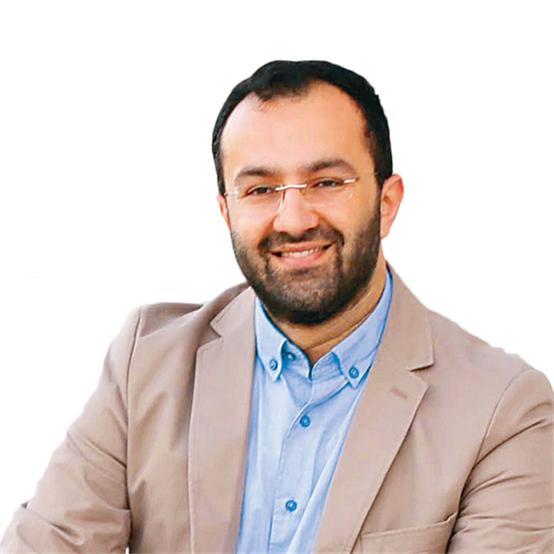We are in al-Khalil after a 40-minute journey through the flashy and well-kept neighborhoods of West Jerusalem. A Palestinian city with a population of about 250,000, named after “Khalil,” Prophet Ibrahim’s epithet cited in verse 125 of Surah an-Nisa, meaning “friend.” As it is evident from the vineyards and fertile lands we see on the right and left along the way, most people in the city get by through means of agriculture and trade.
The foreign neighborhoods we first encountered in al-Khalil are not different from any other Palestinian city. In fact, it could even be stated that they are very lively and dynamic compared to their equivalents. There is no conspicuous negativity here with streets oscillating between order and disorder, restaurants, shopping places and people filling streets.
When we move on to the old part of the city following the signs of "Masjid Ibrahim,” the vitality suddenly vanishes. A discernible anguish, stagnation and silence meets us here. Finally, as we head toward the Cave of the Patriarchs, where Ibrahim and his family are buried, we are confronted with an almost abandoned city. There are hardly any people on the streets other than a few children trying to sell their bits and bobs to visitors.
We walk into the bazaar passing through historic stone houses, some of which have exceeded at least two centuries. Most of the shops are closed. When we turn left on the main road in the bazaar, we see the entrance of the complex right across us. There awaits perhaps the biggest shock to a Muslim who visits al-Khalil: You can only enter the mosque with the permission of Israeli soldiers through a turnstile. The frustrating situation of Israeli soldiers guarding the gates of Masjid al-Aqsa in Jerusalem is really nothing when compared to this picture.
The Cave of the Patriarchs (also named al-Haram al-Ibrahimi among Arabs), which was built during the Ayyubid dynasty and underwent a comprehensive renovation in the last period of the Ottoman Empire, is no different from any historical building when looked at from the outside. But a second shock meets visitors inside: the mosque is divided down the middle into two. The tombs of Prophet Ishaq and his wife Rifaqah are in the section dedicated to Muslims' worship today. The tombs of Ibrahim and his wife Sarah are in between the divided areas, while the tombs of Prophet Yaqub and his wife Leah are in the section that is now assigned to Jews. Since this is opened to Muslims only twice a year, most visitors cannot see these tombs.
After a visit to the mosque, it is possible to take a short stroll along the Old City of al-Khalil. Our aim is to provide financial support to locals while visiting the bazaar, which has nothing but local products. Keeping this in mind, we conclude our shopping without much bargaining. However, from the middle of the bazaar, we face a third shock and a bitter reality of the city: Here, the upper part of the bazaar is covered with wire fences and nets. The objective is to prevent the Zionist settlements, occupying the upper floors, from throwing garbage and stones at the bazaar. The nets are already filled with garbage in some places.
We leave al-Khalil with confused feelings, apparent anger and most concrete signs of occupation.
* * *
Al-Khalil, which joined the British mandate from 1920 to 1948, came under the administration of the Kingdom of Jordan from the years 1950 to 1967 and was occupied by Israel between from 1967 to 1997, has been under the Palestinian Authority since 1997. However, Israel continues to occupy 20 percent of the city, including the Cave of the Patriarchs and its surroundings, for 'strategic reasons.’
Baruch Goldstein, a Zionist who came from New York and settled in al-Khalil on Feb. 25, 1994, mowed down Muslim worshippers with an automatic rifle during the morning prayer at the Cave of the Patriarchs – a turning point for the region. After the horrific incident, in which 29 Muslims including children were martyred, Israel shut down entrances and exits in the city for six months. Afterwards, the massacre was almost blamed on Muslims; the Cave of the Patriarchs was divided into two and a section of it was allocated for Jews.
The humiliating security measures seen at the entrance to the complex today and the desolation in the bazaar are direct consequences of this policy. Israel keeps the old city of al-Khalil under military control in order to protect the some 400 Zionist settlers inhabited around the mosque. The physical harm the settlers cause the Muslims and the tension they create have transformed al-Khalil into a ticking bomb that could explode at any moment. You can tangibly feel the tension in the city.
* * *
Having been declared an "endangered cultural heritage" by the United Nations Educational, Scientific and Cultural Organization (UNESCO) in recent days, al-Khalil has once again occupied the agenda of politics with this decision. Israeli Prime Minister Benjamin Netanyahu castigated UNESCO's step, while the Palestinian Authority described it as a "diplomatic success.”
It would be enough for Netanyahu just to glance at news and analyses in the Israeli press, instead of getting angry, in order to understand the severity of the matter. Because there are many Israeli journalists and writers who draw attention to the danger caused by the settler terror in al-Khalil. It is indisputable that everyone, with the exception of Netanyahu and his cabinet, is aware of the approaching danger.




















